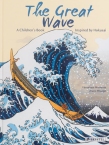 In Japan, the oldest and wealthiest man in the village lives on the hill in his rice farm. In the village below, villagers are getting ready for a festival. Suddenly he senses a problem, and when he sees the waters recede realizes a tsunami is coming. He cannot get down to the village to warn them in time so he needs to draw the villagers to him. As a desperate act, he sets his crop on fire. The villagers rush up the hill to help put out the fire, and they are all saved.
In Japan, the oldest and wealthiest man in the village lives on the hill in his rice farm. In the village below, villagers are getting ready for a festival. Suddenly he senses a problem, and when he sees the waters recede realizes a tsunami is coming. He cannot get down to the village to warn them in time so he needs to draw the villagers to him. As a desperate act, he sets his crop on fire. The villagers rush up the hill to help put out the fire, and they are all saved.
Kimiko Kajikawa, Philomel Books, ©2009, ISBN 978-0-399-25006-4
Tsunami
This is a good time to study the science of the tsunami. These giant waves form where tectonic plates collide, where there is a gigantic (frequently underwater) eruption of a volcano, or after a meteor impact. 86% of all tsunamis come from underwater volcanoes or seismic shifts. These displace huge quantities of water suddenly. The water rushes in to fill the vacuum (thus explaining why the “tide” seems to go out suddenly and unusually far) and then rushes back out again in the form of a huge wave.
There are many websites with great information including the video below.
The True Story
This book is based on a story in the 1897 publication by Lafadio Hearn called Gleanings in Buddha-Fields. The original wise wealthy man of the village was Hamguchi Goryo and there is a Japanese museum dedicated to him. (He was 35, not an old man, when it happened but the story is still wonderful. Making him older makes it possible for “experience” to tell him what to do.) Ask students to research the real person at locations such as The Fire of Rice Sheaves.
For 8 creative writing ideas, click Tsunami to download.
 This is the story of fishermen who are caught in a huge wave that deposits a baby into their arms. He grows up uncertain as to where he comes from or who his real parents are. A fish promises to help him answer his questions. When the boy finally becomes scared, the fish turns into a dragon and says that Naoki now knows that his “real” parents are the ones that raised him.
This is the story of fishermen who are caught in a huge wave that deposits a baby into their arms. He grows up uncertain as to where he comes from or who his real parents are. A fish promises to help him answer his questions. When the boy finally becomes scared, the fish turns into a dragon and says that Naoki now knows that his “real” parents are the ones that raised him.
 In the country, in modern Japan, a little old couple lives quietly. The man says he misses his “rounds” (we don’t know what they are) and his wife makes him some candies so he can go into town on his bicycle and repeat what he used to do. He bicycles through busy streets to where the park used to be and sets up a little theatre. He recalls to himself what it was like to entertain crowds of children with his Japanese tales until television came. Coming out of his reminiscence he sees a crowd has gathered to hear these traditional tales and he gives out the candy his wife made.
In the country, in modern Japan, a little old couple lives quietly. The man says he misses his “rounds” (we don’t know what they are) and his wife makes him some candies so he can go into town on his bicycle and repeat what he used to do. He bicycles through busy streets to where the park used to be and sets up a little theatre. He recalls to himself what it was like to entertain crowds of children with his Japanese tales until television came. Coming out of his reminiscence he sees a crowd has gathered to hear these traditional tales and he gives out the candy his wife made.